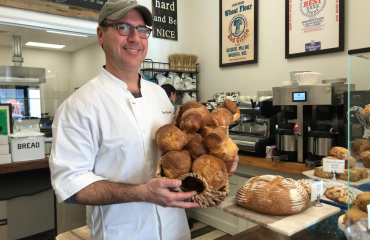How the Rise of the Celebrity Instructor Has Transformed Fitness – The Ringer
Filed under:
In March 2020, the fitness industry was forced to adapt to the onset of a global pandemic. Nearly two years later, many of the changes are here to stay—for good and for bad.
On May 24, 2019, Jessica Menardy fell in love with Jess Sims. Their first run together was a 30-minute “trap fun run” soundtracked by the likes of Rich Homie Quan, Future, and Yo Gotti. Now Menardy sees Sims every day for 20 to 60 minutes, always between 5 and 7 a.m. Sometimes she curses her. Sometimes she adores her. But she always comes back.
“Oh my God, that woman,” Menardy says, reflecting on their first meeting. “May 2019 will forever be a special time for me, because finding her … that was my therapy.”
Menardy is a 34-year-old tax accountant who lives in suburban Los Angeles. Sims is a strength, running, and walking Peloton instructor who has 375,000-plus Instagram followers and a Reebok sponsorship. Sims appears in Menardy’s home via the 32-inch touch screen attached to the latter’s Tread+. Menardy can’t remember going a week without taking a Sims class since that first run.
“Peloton makes me feel like an athlete, and I needed that,” she says. “I needed to feel so empowered and so incredible during my workouts, especially when I felt so small in life. When I felt small, during postpartum. So, those were the moments. The moments were just simple. When I felt like I was me, I wasn’t just a mom. I wasn’t just here to pump milk. I was an athlete. So it was very, very life-changing and I am forever grateful.”
The past two years have significantly altered our relationship with personal fitness. The widespread shuttering of gyms and studios beginning in March 2020 led to an uptick in the usage of apps and streaming workouts, and the threat of a debilitating virus prompted many to take a renewed focus on their physical well-being. Fears of the “quarantine 15” led to public health studies and explanations from the Yale School of Medicine; a March 2021 report from the American Psychological Association found that 61 percent of adults reported undesired weight changes since March 2020, and that 42 percent reported unintended weight gains. As at-home fitness took on outsize importance, so did its instructors. Fitness professionals garnered more fans and followers, and with that exposure came a degree of celebrity ranging from microinfluencing to major brand partnerships.
Cycling instructors and yoga teachers have now hobnobbed with Russell Wilson and Ciara, appeared in Super Bowl commercials, garnered spots on Dancing With the Stars, made ill-fated appearances in the Sex and the City reboot, and proferred up their dogs for magazine profiles. At the same time, they’ve never been more accessible. Trainers’ posts, reels, and TikToks have both fueled their celebrity rise and allowed them to connect with the public in an intimate and immediate way. People are now more likely to see fitness instructors as celebrities, and more likely to feel that they know them on a personal level. These trends have caused the industry to boom, reframed the nature of the fitness influencer, and raised questions about what comes next—and whether the revolution in how trainers and trainees interact is healthy or sustainable in the long term.
Menardy breaks down her experience of the past two years simply. “Say Oprah and Tunde were walking down the street,” she says, referencing Tunde Oyeneyin, a Peloton cycling instructor known for sporting bright red lipstick through the gnarliest of workouts. “I would be just as freaked out with both. They’re really that important to me. … I think I would have the same reaction because they mean so much to me, and they’ve impacted my life in different ways.”
One major difference between the two: Menardy has been able to tag Tunde after a tough workout and get a direct message response. Oprah likely isn’t in the business of responding to her Instagram DMs.
Parasocial relationships are connections formed between an individual and a public figure in which the former comes to feel they know the latter as a personal friend. The term first appeared in a 1956 study by University of Chicago anthropologist Donald Horton and sociologist R. Richard Wohl. The idea is that we create connections with those who entertain, enlighten, and inform us, even if they never know we exist. Over the past couple of years, both the term and concept have become more relevant than ever.
In the intro to their study, Horton and Wohl note that “public platforms and theatres” have fostered parasocial relationships with “people of the world of affairs”: fictional characters, television and movie stars, even anthropomorphic puppets. The pair focused on a “special category of ‘personalities’ whose existence is a function of the media itself,” like interviewers or announcers. These personae, as the study calls them, “offers, above all, a continuing relationship. His appearance is a regular and dependable event, to be counted on, planned for, and integrated into the routines of daily life. His devotees ‘live with him’ and share the small episodes of his public life—and to some extent even of his private life.”
Through the years, the public figures on the other side of these bonds have shifted with changing technology: 1800s parasocial interactions (or PSIs) revolved around literary characters; the 1900s brought TV and film stars; this century, it’s expanded to social media stars and influencers. The latter category encompasses everyone from YouTubers to mommy bloggers. And it certainly includes fitness professionals like Sims and her colleagues.
In early 2020, the members of Black Girl Magic, a Facebook group of more than 27,000 Peloton users, planned a meetup at the Red Rooster restaurant in Harlem. One of the organizers reached out to Sims and Oyeneyin to invite them to the gathering, which they expected to draw about 100 members.
“Tunde and I popped up on them and surprised them, and when I tell you, I had my Beyoncé moment,” Sims says. “I thought the building was going to fall over, they screamed bloody murder. I’m telling you, I was really like, ‘Tunde, are we Beyoncé? What’s happening?’”
Sims doesn’t think of herself as a celebrity. She grew up in Massachusetts, played basketball at Trinity College in Connecticut, and landed in Houston after graduating through a Teach for America placement. She worked her way up through school leadership positions in the Northeast, became the principal of a charter school in Harlem, and then left education to pursue a full-time fitness career in 2016. Over the past two years, she has stumbled upon people doing her workouts in a park. Fans come up to her on the street and begin talking to her like an old workout buddy.
“They’re like, ‘Jess, we’re best friends, we work out every day, six days a week,’” she says. “It’s so funny, cause then I’ll stop and say, ‘I’m Jess,’ and they’re like, ‘I know!’”
The pandemic served as a natural flashpoint for these types of connections. According to multiple researchers, PSIs can be a response to an internal deficit in which an individual seeks to find a sense of belonging, build self-esteem, or counter loneliness. Per researcher Carol Laurent Jarzyna, COVID-19 created an “externally produced deficit” in the lives of millions; never before had so many people been limited in day-to-day socialization and physical contact. In a November 2020 article, “Parasocial Interaction, the COVID-19 Quarantine, and Digital Age Media,” Jarzyna wrote that “PSI through digital media allowed us to have a sense of togetherness during the quarantine. … Research has shown that this type of PSI gives us a feeling of belonging, helps us feel closer to our ideal selves, and raises our self-esteem. These are important things in times of fear.”
Consumption habits have facilitated these connections, too. In the past few years, people have upped their phone and computer usage—some statistics suggest that in the early weeks of March 2020, internet usage increased by 50 to 70 percent, and that social media went up by half—which only increased people’s exposure to potential parasocial relationships. Multiple studies have found that the “always on” nature of social platforms like Twitter, YouTube, and Facebook “promotes increased parasocial interaction and relationship development.” And influencer-friendly apps have thrived since the onset of the pandemic: According to data from SimilarWeb, TikTok’s average monthly visits increased 576 percent in 2020; the app had 55 million global users in January 2018, and crossed the 1 billion user mark last September. More than half of the users were between 18 and 34 years old, but the number of users aged 35 to 44 more than doubled in the past year.
“It’s not just Gen Z and younger millennials who follow influencers. People of all ages started following influencers for that entertainment content, right?” says Mariah Wellman, a PhD candidate at the University of Utah who studies social media, influencers, and health communication. “I don’t know if that necessarily changes the definition of celebrity, but it definitely expands on what we consider to be a popular person, worthy of consumption.”
This expansion has had a profound impact on the fitness economy. Fitness was already a nearly $100 billion industry before the pandemic. Between March and October 2020, the revenue from health and fitness equipment more than doubled. Between January and November of that year, approximately 2.5 billion health and fitness apps were downloaded, amounting to a 47 percent increase from the prior year. The ACSM report on fitness trends found that the no. 1 trend for 2021 was online training, in comparison to its being no. 26 in 2020.
“Those who were able to capitalize on that, really blew up quickly, because people were fearful,” Wellman says. “People were also at this time talking about how immunity is really important, right? And cardiovascular health. It’s not just the physical, the look of your body, but internal health and people were like, if you don’t have a workout program, you should get a workout program.”
Related
In the months since, there’s been big money to be made in selling wellness: Kayla Itsines sold her Sweat app, an offshoot of her original 12-week Bikini Body Guide, for $400 million in July. Jen Selter, who rose to fame with her glute-building exercises and “belfies,” brings in an estimated $72,200 per sponsored post. Cassey Ho, who first began posting Pilates workout videos to YouTube in 2009 and has amassed 5.5 million followers on the platform, released a Blogilates Home Gym Collection for Target in 2020 and had an estimated income for that year of more than $2 million.
People have cashed in on fitness trends for years, but never at this scope or scale. That’s a reflection of the increased influence of celebrity instructors, for good and for bad.
Before Peloton, Mirror, and Tonal, there was the Hula-Hoop. In 1958, the founders of the Wham-O toy company were gifted one of the bamboo rings that were commonly used during gym class at Australian schools. They began to manufacture plastic versions, and an estimated 100 million to 120 million Hula-Hoops were sold in the first six months on the market, ushering in the first at-home workout craze of the second half of the 20th century. The phenomenon went global: According to a story in The Washington Post, “three Japanese cities banned hooping in the streets, saying the fad ‘contributed to an increase in traffic accidents.’”
The 1960s brought “sauna suits” and speed massage machines. The 1970s introduced Jazzercise. By the ’80s, there was the aerobics trend starring Jane Fonda, Denise Austin, and others. Jane Fonda’s Original Workout, released in 1982, is one of the bestselling VHS tapes of all time. But unlike the fitness stars of today, Fonda achieved fitness fame as an Oscar-winning actress who was able to parlay her big-screen reputation into a lucrative side business. Plus, when the video was stopped and ejected, Fonda’s presence in a user’s life was paused until the next workout session.
“With the access to the instructor’s personal life, we do have an automatic, closer relationship to them than we’ve ever had with any fitness instructor in the ’80s, ’90s, early 2000s,” Wellman says. “It’s not just the hours they’re doing that workout video, but they’re engaging with that instructor possibly countless times throughout the day, and that impacts other areas of their life.”
Robust communities have sprung up around instructors and their services, such as Mirror’s Facebook group for women who work out or the numerous Peloton groups dedicated to individual trainers. Nicole Gonzalez, a mother of two from Westchester County, New York, is an admin and calendar-creator for HardCORE on the Floor, a Facebook group centered on a monthly strength training calendar. Each month, she sorts through available classes in Peloton’s strength, cardio, and yoga disciplines and builds a schedule that hits every major muscle group. In the spring of 2020, the group had 7,000 members. As of this week, membership is approaching 300,000. There are posts of HardCORE members finding each other at hotel gyms on vacation, and a woman learning her nurse in the delivery room was also a calender devotee. One member found out about the group from the person who administered their COVID vaccine. “I use the term ‘tribe’ because it’s like a family of strangers,” Gonzalez says. “It’s not necessarily everyone’s related, but we are a family. We are.”
Many of the HardCORE discussions focus on a given day’s workouts, but there are plenty more about the trainers’ off-topic messaging and what they talked about in that day’s class, whether that’s a non-fitness aside or words of inspiration. Gonzalez sees the instructors as educators first and then influencers, because she says “they practice what they preach.”
“It’s not like the ’90s when you grow up and you saw a celebrity and all you got was an article on Bop,” Gonzalez says. “Here, you can literally interact with them, which is super cool. Maybe I’m aging myself, but in the ’90s you loved all these boy bands, and Britney Spears, and everything. It was just so unattainable to know them, and it’s just kind of mind-blowing for ’90s babies to say, ‘Whoa, I can actually have a conversation with someone I am following and really am impressed by.’”
For all the benefits that come with recent changes to the fitness landscape, however, these types of deepened connections with instructor influencers can have a dark side. Parasocial relationships can sometimes progress to celebrity worship, and links have been made between PSIs and media addiction and dependency. A 2019 study, for instance, found that social anxiety and parasocial relationships with YouTubers are predictors of YouTube addiction. The same piece notes that “the intensity of parasocial phenomenon on social networking sites appears to be linked to higher degree of addiction to these websites.”
Overwhelming fitness content consumption can also be detrimental to mental health. Constantly scrolling through posts of influencers preening in bikinis and shilling protein powder can negatively affect body image issues and disordered eating habits. Internal research into Instagram, released by a Facebook whistleblower in early October, showed that the app worsens eating disorders in teenage girls. A leaked study showed that 17 percent of teenage girls said that using Instagram worsened their eating disorders, and 32 percent said it made them feel worse about their body.
And some fitness influencers have tried to cash in on this new landscape despite lacking formal training or certifications. Take Chloe Ting, who gained more than 3 million followers in May 2020 thanks largely to the #ChloeTingChallenge on TikTok, which garnered more than 215 million views by July of that year. She advertised quick fixes and spot reduction, two concepts that counter most accepted fitness knowledge and can set unrealistic expectations for workout results.
Casey Johnston says the key to navigating this fitness landscape is by embracing a holistic approach that accounts for diet, stress management, sleep, and more. As the author of the She’s a Beast newsletter and Liftoff: Couch to Barbell, Johnston provides insights that help her readers become stronger physically, mentally, and emotionally—and she says that people’s experiences with fitness influencers can be a “double-edged sword.” If a program or regimen goes well, users can grow even more enamored of an instructor for guiding them to a healthier life. If one flops, Johnston says, they could “enter a period of dissolution … where it’s like, ‘Now I’m actually mad at them, because they lied to me.’” Johnston says users often “feel guilt or a sense of shame that they couldn’t live up to the bar that this person was setting.”
Fitness influencers aren’t selling a product as much as they’re selling you “a better version of you,” Johnston says. This can make them seem more relatable—and more apt to become the focal point of a relationship that can become unhealthy. Their message is that the difference between your life and theirs may be this yoga practice, or weight-lifting routine, or keto diet. “[It’s] like, ‘You don’t like your life that much,’” Johnston says. “‘I have the tools with which you can at least change a couple aspects of it. And I’m going to make it easy, and look at me. I’m living my best life.’”
Perhaps the most enduring change in fitness over the past two years is how aspiring weight lifters and at-home yogis find their next trainer. There is a lot more flexibility in how interested consumers connect with professionals, and how the latter are able to market their skills—a trend steeply accelerated by the pandemic, which shows no signs of abating. In Johnston’s view, the enhanced options are a positive.
“It’s never been easier to find somebody who aligns with you ideologically, in terms of how to train, or what to eat, or how hardcore you’re supposed to be, or these kinds of things,” she says. “It used to be limited to just whatever trainers were at the gym you signed up at, and now you can go online and find somebody who’s pretty precise.”
Some virtual trainers and coaches are content to keep their online presence limited strictly to fitness information. There’s money to be made even for those who aren’t social media stars inundated by fawning comments about everything from athleisure to wedding planning. “The people who are not quite at that millions-of-followers level of social fervor, they still can maintain a very good living, even though people aren’t necessarily stanning their personality,” Johnston says. “[Success] doesn’t require necessarily selling your entire personality and soul, along with your services, online.”
On the flip side, there are consumers who crave a window into a fitness coach’s life just as much as their HIIT circuits. These types of instructors face the challenge of maintaining attention and relevance in an extremely saturated market. According to Wellman, people may move around from one trainer to the next until they find one with whom they identify.
“Once that happens, oftentimes they’re staying not only for the creativity, but also for this parasocial interaction, this parasocial connection, that they have to other parts of the creator’s life,” Wellman says. “It’s not just that they post at-home workouts, but maybe they also have a toddler, or they also have a 7-year-old who’s back at school. And they talk about those things. Or they’re going through a divorce. It’s all these very personal, intimate things that they can be more transparent with.”
Check your inbox for a welcome email.
In the best-case scenario, the relationship between trainee and trainer can look a lot like the one between Menardy and Sims. After Menardy kept responding to Sims’s Instagram posts with witty one-liners, she began tagging her in her own workout posts, and Sims would comment on Menardy’s form. At one point, Menardy felt comfortable opening up to Sims about how much her classes had helped her in her postpartum period.
“I was like, ‘My gosh, you and I were destined to be in each other’s lives,’ and it’s just easy,” Sims says. “She’s just one of my homegirls. We have so much in common, too: music tastes, and lifting heavy weights, and food. We talk about food all the time.”
Now they chat almost every day, Sims says, maybe more than some of her friends she sees in person. Theirs is a parasocial connection that evolved into genuine friendship. As Menardy puts it, she can get a workout with any instructor. But Sims, she says, has a special gift. “Just her energy, her positiveness. It’s something that I need in my life. It’s kind of like therapy.”
Cultivating a real-life relationship with one’s favorite instructor may not be possible in most cases, but for many people that isn’t the goal. As online workouts continue to dominate the fitness world and social media bridges the gap between the public and private spheres, a new standard for how we engage with trainers has been set. A confluence of factors have crystallized to transform the fitness industry, and many of the changes from the past two years are here to stay. For Sims, this new landscape has opened up a world of possibilities—and brought a set of responsibilities with trainees that she doesn’t take lightly.
“I share a lot of things while I’m teaching and we’re looking right into the members’ eyes,” she says. “They feel this deep connection that they might never feel with any other celebrity. The relationship just gets deeper and deeper.”
An SB Nation affiliate site




